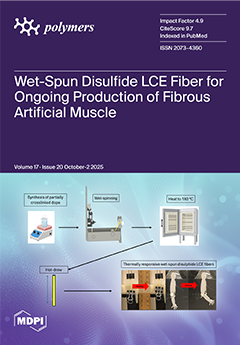A series of PTT-
b-PTMG copolyesters was synthesized via direct esterification followed by melt polycondensation using purified terephthalic acid (PTA), bio-based 1,3-propanediol (PDO), and poly(tetramethylene glycol) (PTMG) of varying molecular weights (650–3000 g/mol). The resulting materials were comprehensively characterized in terms of
[...] Read more.
A series of PTT-
b-PTMG copolyesters was synthesized via direct esterification followed by melt polycondensation using purified terephthalic acid (PTA), bio-based 1,3-propanediol (PDO), and poly(tetramethylene glycol) (PTMG) of varying molecular weights (650–3000 g/mol). The resulting materials were comprehensively characterized in terms of chemical structure, molecular weight, thermal behavior, phase morphology, crystalline architecture, and mechanical performance using a range of analytical techniques: Fourier-transform infrared spectroscopy (FTIR),
1H-NMR, gel permeation chromatography (GPC), differential scanning calorimetry (DSC), thermogravimetric analysis (TGA), wide-angle X-ray scattering (WAXS), small-angle X-ray scattering (SAXS), dynamic mechanical thermal analysis (DMA), tensile testing, and other standard physical methods. FTIR,
1H-NMR, and GPC data confirmed the successful incorporation of both PTT-hard and PTMG-soft segments into the copolymer backbone. As the PTMG molecular weight increased, the average sequence length of the PTT-hard segments (L
n,T) also increased, leading to higher melting (T
m) and crystallization (T
c) temperatures, albeit with a slight reduction in overall crystallinity. DMA results indicated enhanced microphase separation between hard and soft domains with increasing PTMG molecular weight. WAXS and SAXS analyses further revealed that the crystalline structure and long-range ordering were strongly dependent on the copolymer composition and block architecture. Mechanical testing showed that tensile strength at break remained relatively constant across the series, while Young’s modulus increased significantly with higher PTMG molecular weight—concurrently accompanied by a decrease in elongation at break. Furthermore, the elastic deformability and recovery behavior of PTT-
b-PTMG block copolymers were evaluated through cyclic tensile testing. TGA confirmed that all copolyesters exhibited excellent thermal stability. This study demonstrates that the physical and mechanical properties of bio-based PTT-
b-PTMG elastomers can be effectively tailored by adjusting the molecular weight of the PTMG-soft segment, offering valuable insights for the rational design of sustainable thermoplastic elastomers with tunable performance.
Full article






